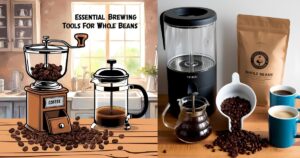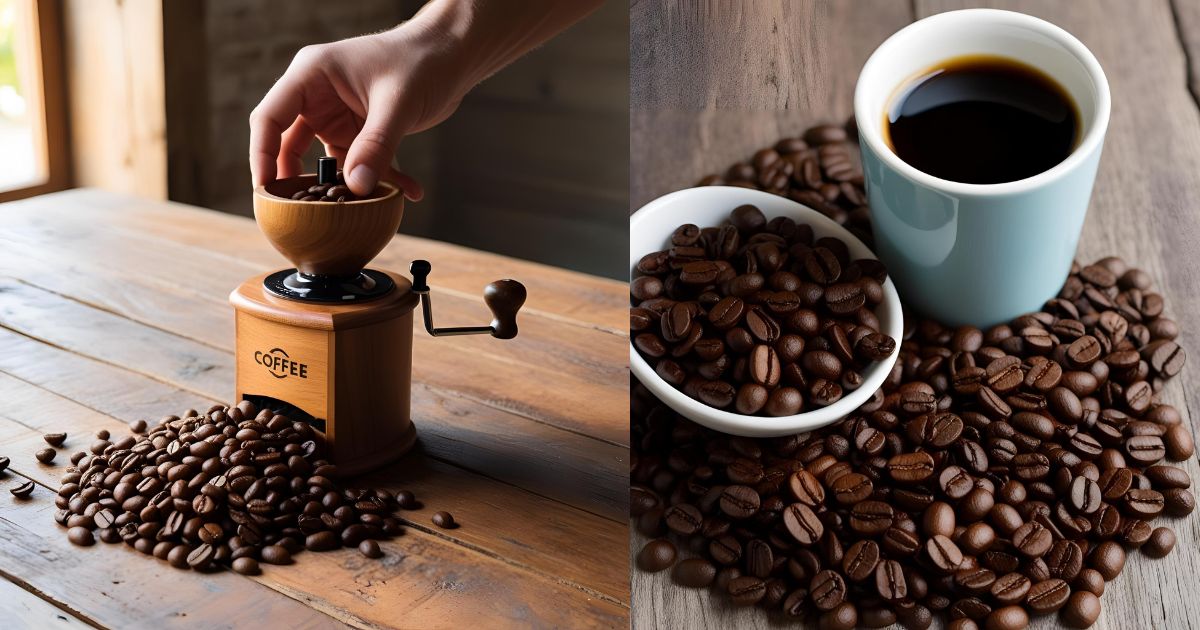Last updated on December 1st, 2025 at 05:36 pm
Most people grind their beans before brewing. But what if you could skip that step — and still enjoy a bold, flavorful cup?
How to Make Coffee With Whole Coffee Beans isn’t just a kitchen experiment. It’s a brewing method that preserves freshness, unlocks rich oils, and delivers a surprisingly smooth taste.
No grinder? No problem. All you need is hot water, time, and a few smart techniques.
In this guide, you’ll discover step-by-step methods that work — whether you’re brewing at home, on the go, or off the grid.
Ready to break the rules of coffee and make your cup stand out? Let’s get started.
Why Brew with Whole Coffee Beans?
Grinding your coffee too early kills the flavor before it hits your mug. That’s because once beans are ground, they start losing aroma, oils, and freshness—fast.
When you brew with whole coffee beans, you lock in that flavor. You’re working with coffee at its freshest point, right before it’s extracted.
Let’s break down why this method works—and why it might become your new go-to.
Retains Natural Oils & Aroma – Less Oxidation than Ground Beans
Those rich coffee oils? They’re fragile. As soon as you grind beans, air starts breaking them down.
Brewing whole beans slows that process. It keeps the natural oils and aromatic compounds intact until the very last second.
Sites like Food52, U3 Coffee, and Aerial Resupply Coffee back this up: when you skip the grinder, you protect flavor from early oxidation. Even Reddit users experimenting at home noticed the difference.
Easy & Equipment-Free Method – No Grinder or Filters Needed
Let’s face it—grinders can be noisy, messy, and expensive. And if you’re traveling or camping, you might not have one anyway.
Brewing with whole coffee beans eliminates the need for special gear. All you need is hot water, a container, and some patience.
That’s why guides from Aerial Resupply Coffee highlight this method as a minimalist’s dream: zero gadgets, just results.
Unique Taste Experience – Mild, Less Bitter Extraction
Expect a smoother cup. Whole-bean brewing extracts flavor slowly, which means less bitterness and more subtle tasting notes.
It’s a mellow experience—ideal if you’re sensitive to acidity or just want something different than your usual pour-over.
Coffee lovers at U3 Coffee and Aerial Resupply say it delivers a gentler flavor profile that’s perfect for sipping slowly.
Quick Overview: Whole Bean Brewing Methods
There’s more than one way to brew whole beans. And none of them are complicated.
Here are four proven methods anyone can try:
Simmer stovetop infusion – heat the beans gently in a sealed jar using a water bath
Cold‑brew style steeping (12–24 hr) – soak beans in cold water overnight for a smooth, low-acid brew
Batch method in a mason jar – simple, portable, and great for experimenting
Slow-cooker or crock-pot infusion – a hands-off option for bigger batches
Each one offers a unique flavor and fits different lifestyles. Up next, we’ll break down each method step by step so you can pick the perfect one.
Method 1 – Stovetop Simmering (Hot Whole Bean Brew)

Want hot coffee without a grinder? The stovetop simmer method is your best bet. It’s simple, hands-on, and delivers a warm cup straight from whole beans.
Here’s how to do it right.
What You’ll Need
You don’t need fancy gear—just basic kitchen tools:
Whole coffee beans (¾ cup)
Hot water (enough to nearly fill your jar)
A mason jar with a lid (or heatproof container)
A medium saucepan
A strainer or cheesecloth
This setup mimics a gentle water bath, similar to a double boiler. It prevents burning the beans and ensures even flavor extraction.
Step-by-Step
Measure your ingredients
Use about ¾ cup of whole coffee beans.
Fill a mason jar with hot water, leaving 1–2 inches at the top.
Create a simmering water bath
Place the jar in a saucepan.
Fill the pan with water so it reaches about ¾ of the way up the jar.
Bring the water to a gentle simmer—don’t boil.
Simmer for 45–60 minutes
Let the jar sit in the water bath.
Stir the mixture gently every 15–20 minutes.
Check water levels to avoid drying out the pan.
Strain and serve
Carefully remove the jar (it’s hot!).
Use a mesh strainer or cheesecloth to pour your coffee into a mug.
Add water or milk to dilute if it’s too strong or thick.
This method has been validated by U3 Coffee, Bean Poet, Food52, and countless Reddit tinkerers.
Flavor Notes & Strength
Expect a mild, mellow flavor—not as bold as espresso, but smooth and rich in aroma.
Because the beans are whole, extraction is slower. Some people describe the taste as less bitter and more earthy, though occasionally on the weaker side if not steeped long enough.
Troubleshooting Tips
Coffee too weak?
Extend the simmer time to 60–75 minutes.
Try preheating your water before starting.
Use a darker roast for more punch.
Coffee too strong or gritty?
Add a splash of hot water after straining.
Make sure your strainer is fine enough to catch loose bits.
Want to reheat it later?
Gently warm over the stove. Avoid boiling—it can flatten the flavor.
This method is perfect for those who love ritual and don’t mind a little waiting for a unique, grinder-free brew.
Method 2 – Cold Brew with Whole Beans

If you’re after a smooth, low-acid coffee you can make overnight, cold brewing with whole beans is your best option.
It takes time, but the flavor payoff is worth it.
Why Go Cold Brew?
Cold brew is naturally less acidic than hot coffee. It’s easy on the stomach, mellow in taste, and perfect for hot days.
Whole beans slow the extraction even more, giving you a smooth, crisp finish without bitterness.
That’s why Food52, U3 Coffee, and SELF all recommend it for anyone wanting a chill, refreshing brew.
Equipment & Ratio
1 cup whole coffee beans
4 cups room-temperature or cold filtered water
A large mason jar or pitcher with a lid
Strainer or cheesecloth
How to Prepare
Add whole beans and water
Combine beans and water in your jar.
Seal the lid and give it a gentle shake.
Steep for 12–24 hours
Let it sit at room temperature or in the fridge.
Shake or stir once halfway through for even extraction.
Strain and enjoy
Use a mesh strainer or cheesecloth to remove the beans.
Store the brew in a sealed container in the fridge for up to a week.
Serving Suggestions
Iced Coffee: Pour over ice for a smooth, chilled drink.
Dilute as needed: Cold brew is often strong—cut it with water or milk.
Flavor it: Add cinnamon, vanilla, or even a splash of almond milk.
Cocktail twist: Mix into coffee-based drinks or cold brew martinis.
This method is low-effort, highly rewarding, and ideal if you plan ahead.
Read Also:
Optional Methods (Quick Mentions)
Slow‑cooker infusion
Similar to stovetop simmering, but completely hands-off. Just set it and forget it.
Campfire/mason jar immersion
Great for camping or hiking. Just add beans to hot water in a sealed jar and let it steep by the fire.
Whole-Bean vs. Ground-Bean Brewing
Let’s be honest—grinding coffee is the norm for a reason. But whole-bean brewing offers some unexpected advantages that might surprise you. Here’s how they really compare.
Extraction Efficiency & Flavor
Ground beans extract fast. That means stronger, more consistent flavor—especially with methods like espresso or French press.
Whole beans extract slower, so the flavor is gentler, less bitter, and more nuanced. You won’t get the same bold punch, but you might prefer the subtlety.
For deep aroma and full-bodied taste, grinding wins. For a smooth, mellow cup, whole-bean brewing shines.
The Grinder Advantage – Flavorful vs. Time & Clean-up
Grinding unlocks oils and aromatics instantly—but it also kicks off oxidation.
Pros of grinding:
Fast, bold extraction
Better for espresso, drip, or pour-over
Customizable grind size = control
Cons:
Messy clean-up
Gear required (not ideal for travel or minimalists)
Loss of freshness if stored too long
As noted by Good Folks Coffee, Food52, and Almost Practical, grinders give you options—but also more to manage.
When Whole-Bean Brewing Shines
Whole-bean brewing isn’t just a novelty. It’s practical in the right context.
Perfect backup when your grinder breaks
Great for camping or travel—no gear needed
Keeps beans fresher longer since you’re not exposing the insides until brew time
If simplicity, freshness, and experimentation matter to you, whole-bean brewing delivers in ways ground coffee can’t.
It’s not about replacing your grinder—it’s about having a flexible, flavorful Plan B.
Bean Selection & Preparation Tips
Want the best flavor from whole beans? Start with the right roast and store them smart.
Choose medium to dark roasts
These give you fuller body and deeper flavor when brewing without grinding. Light roasts often taste too weak in whole-bean methods.Store in airtight containers
Exposure to air kills flavor. Use sealed jars or vacuum canisters to keep beans fresh and oxidation out.Avoid sunlight and moisture
Heat and humidity speed up spoilage. A cool, dry cabinet beats a countertop every time.Use freshly roasted beans when possible
According to The New York Post, high-altitude, freshly roasted beans not only taste better—they may offer health benefits too.
Whole-bean brewing doesn’t forgive stale beans. Treat your beans well, and they’ll return the favor.
Conclusion
You don’t need a grinder to make great coffee. Whole-bean brewing proves it.
Whether you choose the stovetop simmer or the cold brew method, both offer bold flavor and a unique brewing experience.
The simmer method delivers warmth and ritual. Cold brew brings smooth, low-acid refreshment.
Try both. See which one fits your taste, lifestyle, or even your mood.
Coffee doesn’t have to be complicated—just fresh, intentional, and made your way.
Ready to experiment? Grab your beans and start brewing. Your next favorite cup might be the one you never ground.
Troubleshooting & FAQs
Can I use green or unroasted beans?
No. They don’t extract properly and will taste earthy or sour. Always use roasted beans.
Why is my coffee weak?
This usually means not enough time, too few beans, or cool water. Try simmering longer or increasing your bean-to-water ratio.
Is whole-bean brewing safe?
Yes. There’s nothing harmful about it. Just be sure your beans are roasted and stored properly.
How do I make it stronger?
Simmer longer (up to 75 minutes)
Use dark roast beans
Reheat gently to concentrate flavor
Add a cinnamon stick or clove during brewing for intensity
These quick fixes can turn a flat brew into a flavorful, satisfying cup.

Shahriar brings a unique blend of storytelling prowess and digital expertise to Daily Coffee Guide. With a background in SEO and content strategy, he ensures our articles on Beans, Coffee, Tea, and Drinks are both engaging and discoverable. His passion for coffee culture drives him to explore and share the rich narratives behind every cup.

